- Home
- Fishing Techniques
- Drift Fishing
How to Tackle Drift Fishing
Drift fishing is a boat fishing technique in which the boat is allowed to move freely with wind and current over likely fish concentrations. The direction of the drift depends of the strength and direction of the two factors that influence it - wind and current.
Unless they're both going in the same direction, the direction of the drift will be somewhere between the two, and obviously closer to the predominant one.
Clearly, when you're positioning your boat such for it to drift over a particular location you'll need to take this into account.
The primary attraction of fishing on the drift is that you cover a lot more ground than you would if the boat was anchored.
But you need good sea conditions to fish 'on the drift' effectively.
It will be practically impossible to make you bait or lure look enticing to a fish if the boat is bouncing around in a big sea, being wind-blown across the current or swept rapidly along by the tide.
Drift fishing can be either a specialised form of bottom fishing, or mid-water fishing with jigs and flying-collar set-ups.
Let's take a look at the most popular drift fishing applications...
Drifting for Flatfish
Flatfish, by which I mean primarily plaice, flounders and dabs, favour sandy bottoms, and spend most of their time blended into it with just their eyes protruding. They're on the look-out for tasty morsels drifting past in the tide.
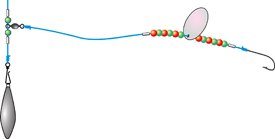 Flounder Rig
Flounder RigSo fishing on the drift is a great technique to use for flatties, and there's a specialised flatfish rig just for it.
Either a spinning rod, or a light boat rod with either a multiplier or fixed-spool reel loaded with 10lb line will be just the job.
As bait, nothing beats a small lugworm or ragworm threaded on a Mustad Aberdeen fine-wire, long shank hook.
Make sure that your rod is either firmly attached to the boat with a lanyard, secured in a rod-holder, or you're hanging onto it at all times. Otherwise if you snag on something, it's gone.
Drift Fishing with Feathers for Mackerel
When summer boat fishing off UK shores, the first task is often to catch some mackerel to use as bait. If your boat is equipped with a galley, I strongly recommend that you don't use all of it as bait.
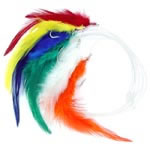 String of Feathers
String of FeathersThe best way to find a mackerel shoal is to watch the birds. Mackerel feed mainly on brit (small fry), and chase them to the surface in doing so, where the birds will take advantage of the situation.
Having located your shoal, position the boat upwind of it and drift through, jigging with mackerel feathers or hokkais. You'll probably catch several at a time.
Drifting over Wrecks and Rough Ground
When drift fishing over rough ground you'll normally find the fish fairly close to the bottom.
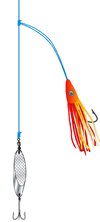 Pirk + Muppet Drift Rig
Pirk + Muppet Drift RigJigging with artificial lures, like the pirk (a dexter wedge in this example) and muppet rig shown here, will catch these fish.
First though, you've got to know where these places are, and when will be the best times to fish them. Fairly slack tides are what you need, so other than on the smallest of neap tides, the best times for drifting over these marks will be the two hourly period spanning high and low water.
But how do you know where to look for these places? Just take a quick look at nautical charts to find out, but don't forget to return here.
Ah good, you're back, so getting back to drift fishing...
When jig fishing close to the seabed with this rig, the technique is to lower it until you touch bottom, then take a couple of quick turns on the reel to avoid snagging. Sweep the rod upwards, then lower it allowing the lures to flutter back down again. Repeat the process until you hook a fish or your arms drop off. Putting a sliver of fresh mackerel on the muppet hooks will do your chances no harm at all. Of course, instead of muppets you could use shads or jellyworms, or hokkais.
Flying Collar Rig
When drift fishing over a wreck, many anglers favour a flying-collar rig used with an artificial sandeel or jellyworm.
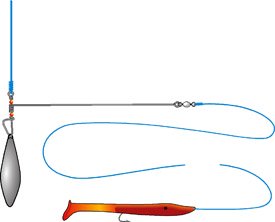 Flying-Collar Rig
Flying-Collar RigWith a weight rather than a pirk at the lowest point there is much less chance of snagging on the seabed or the wreck.
The technique is different too. Lower the weight until you feel it touch, then reel up slowly about twenty turns or so.
No takers? Then stop, drop it down again and repeat the process. When you get a take, don't strike, just carry on winding.
The fish, if it had just grabbed the tail of the lure, will take another gulp - and you've got him!
Recent Articles
-
Sea Fishing Rods and Reels Must Be Compatible for a Balanced Outfit
Mar 08, 21 08:30 AM
A quality reel fitted to a quality rod doesn't necessarily make it a quality outfit. Your fishing rods and reels have to be properly matched if you're to get the best out of them, and here’s how -
Essential Lure Fishing Tips That All Saltwater Anglers Should Know
Mar 08, 21 04:51 AM
Which single lure fishing tip applies to trolling, jigging, baitcasting, spinning, fly fishing and any other branch of lure fishing? Well, it is the one at the top of this list -
Vital Jig Fishing Tips That You Really Cannot Afford To Miss!
Mar 07, 21 10:20 AM
Essential jig fishing tips to help you select the right lure for successful jig fishing, together with the techniques required to get the most out of your jig fishing outfit
















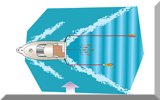

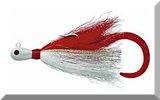
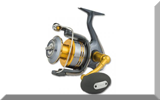
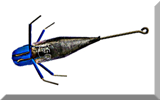
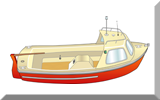
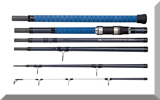
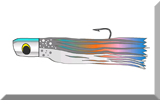
New! Comments
Have your say about what you've just read! Leave me a comment in the box below.